Drone Surfing Hits the Waves (seeker.com, 9/12/16)
Drones are everywhere in society, and now they are making their way even into our sports. A heavy-duty drone made by Freefly Systems (manufactures of various cameras and cinematic equipment) was able to pull a person on a board across the water using a tow rope. While the ride may be fun, there are definitely some disadvantages to surfing with a drone. These include the cost of the drone, battery life, and even getting moving quick enough to surf without having to first start on the land. It’s probably pretty safe to say that drone surfing won’t replace kite surfing anytime soon.
-Donovan Wixom
GenDyn demos capabilities of underwater drone (Richard Tomkins, 9/12/16)
Military use of drones now has the capability to expand to underwater missions. The U.S. Navy has recently sponsored research to test the capabilities of mini-drones in underwater environments. Tests have proven successful for the Bluefin-21 AUVs, which may be adapted to launch smaller drones, or to carry surveillance and reconnaissance devices. The 15-pound drone may be used for a variety of purposes, including “intelligence collection, surveillance and reconnaissance, mine counter-measures, sea-floor mapping and imaging.” According to officials, these drones have significantly improved navigational capabilities and longer endurance than previous models.
-Rachel Nelson
New drone technology will uncover secrets of Amazonian tribes (9/12/16)
Drone technology of the 21st century will now be used to uncover mysteries thousands of years old in the Amazon Rainforests of Brazil. In a partnered effort with the University of Exeter and the National Institute for Space Research in Brazil, researchers plan to study how indigenous peoples shaped the landscape of the rainforest, an area considered to be crucial to global climates and regulation of the carbon cycle. The team will use a fixed-wing drone, which will be one of the first to have a high-quality laser attached to survey and model the area as well as zoom in on locations for further study by archeological digs. The team plans to begin their field research in October.
-Rachel Nelson
xCraft’s 100-mph drone is about as fast as they come (Eric Mack, 9/12/16)
Good news for drone enthusiasts who have a need for speed! xCraft is a drone company that first gained public notoriety on the television show Shark Tank. Now they have a new drone breaking headlines as possibly the fastest RTF (ready-to-fly) drone available so far. Boasting a top speed of just over 100mph, this little drone makes use of an innovative “booster motor” in the rear of the aircraft. The new drone should provide a great thrill for drone races, and it also shows just how advanced consumer drone technology has become. There is now a drone that can fly faster than cars are allowed to drive on most major roads.
-Alexander Reifsnyder
DE’s New Drone Laws Strike Balance Between UAS Growth, Safety: Agency (Betsy Lillian, 9/13/16)
A new bill in Delaware regulating the use of drones may be the right balance of restrictions and encouragement. The bill, signed on September 6ths, prohibits the use of drones in emergency areas and areas or events that are highly populated. It also states exactly what the punishments will be for breaking the law a first and a second time. Finally, it prohibits local and city governments from making laws about drone use, reserving that right for the state and federal level. The Delaware River and Bay Authority (DRBA) is really excited about the new law. They feel that the prohibitions on drone use are necessary for safety, and not too obtuse for drone users. They also state that by restricting the right to make laws to a state level, it stops various and contradicting regulations from being made, making it easier to start a new business and develop new technologies.
-Donovan Wixom
Doctors Test Drones To Speed Up Delivery Of Lab Tests (Ester Landhuis, 9/13/16)
Doctors are now in the process of testing drones for the delivery of lab tests. If tests are successful, doctors hope to be able to transport blood samples and other specimens as well as medical supplies. According to Dr. Geoff Baird, drones could soon “transform health care — not only in rural areas by bringing critical supplies into hard-to-reach places, but also in crowded cities where hospitals pay hefty fees to get medical samples across town during rush hour.” While drones are also being tested to deliver products, such as packages for Amazon, those in the medical field must confront additional problems. For example, it is yet to be determined if the cells in a blood sample are affected in any way during drone transit. Initial tests look promising, however. During one test, doctors compared blood samples (taken from healthy volunteers) flown by a drone for 40 minute to samples from the same volunteers that sat stationary. The 33 tests produced equivalent results for both groups. While many questions remain unanswered, such as what happens if a drone carrying samples were to crash, it is possible that drones will be integrated into the medical field in new ways in coming years.
-Rachel Nelson
Holland’s drone-hunting Eagles are Ready to Fly (Amar Toor, 9/13/16)
Rather than integrating drones, Dutch police are taking the opposite approach–anti-drone technology if it can be called as such–to protect airports and other crowded or potentially hazardous areas. In 2015, police in the Netherlands, who will be the first to use birds for this purpose, began training eagles to take down drones when one is suspected of flying in controlled areas, and recent tests have proven successful. According to authorities, the eagles simply view drones as prey, and from there, predatory instincts take over. While concerns have arisen from animal rights activists over the birds’ new employment, police spokesman Dennis Janus replied, “none of the eagles were hurt, but as for the drones, none of them survived.”
-Rachel Nelson
Israel Denies Claims That Syria Shot Down Warplane and Drone (Isabel Kershner and Anne Barnard, 9/13/16)
The Israeli army denied having a drone shot down by Syrian anti-aircraft fire early last week. There is some speculation as to whether or not this is true, and it raises two important points about the use of drones as military tools. The first point is that, even if the drone was shot down, it does not involve the lives of soldiers. If a drone can replace even a few people in the field that is nothing but good news. The other important point is that a military force can now potentially disclose less about what happens in a war because there is no longer the obligation to report to soldier’s families when a plane is shot down. It’s a shame when a four million dollar drone is lost, but it is much better, and lower profile, than losing a soldier.
-Alexander Reifsnyder
Drone Racing Becomes ESPN’s Newest Televised Sport (Daniel Victor, 9/14/16)
As drones become more and more common in everyday life, people are curious about them and want to see more. This demand has been met with the announcement that ESPN will now broadcast drone races. They will be pre-recorded segments to make it easier to follow the action. However, with the races being taped and aired separately, the article predicts that the series will be more like reality television and less like a traditional sporting event. There will be 25 drone pilots, each of whom will be given an identical drone that has been “stripped down to the bare minimum.” The competition is scheduled to start October 23 and will air on ESPN2.
-Alexander Reifsnyder
‘Star Trek’ -style surveillance drone for the US military (Allison Barrie, 9/15/16)
There is a new drone used by the military for tracking terrorist actions. The “High Altitude Pseudo Satellite” (HAPS) is a drone that runs on solar energy, and and fly for more than a month without landing. It flies up into the upper atmosphere, 12.5 miles high (high enough to see the curvature of the earth), and does high-definition surveillance similar to the surveillance done by satellites the military already uses. The great thing about a drone, is its more flexible that a drone. One of these flexibilities is that you can land the drone, change out the tech that is on it, and the launch it off again. It is also more versatile than a normal drone because it flies high enough to avoid bad weather and air traffic, making it safer to fly. The drone, which has already broken three world records, is sure to change the landscape of both drones and security.
-Donovan Wixom
What’s Next For Drones? Expect Some Fireworks, Literally (Bill Peters, 9/15/16)
There are a ton of ways that drones are being used in commercial settings. While the FAA has had some strict regulations in the past, in 2014 they gave out their first commercial exception, and they have only given out more since. The aforementioned exception was the BP to fly drones over oil pipes for inspections. Now, there are some applications in for exceptions to use drones as Wi-Fi hotspots to improve communication. Even delivery is getting on the drone band-wagon, and not just Amazon. Domino’s Pizza is looking into a way for drones to deliver pizza to your door. Medical companies are looking into a very similar thing. Similarly to inspecting pipelines, farmers can use drones to inspect fields and crop health. And these are not the only industries being infected by the drone bug. This article will go over even more examples of innovative uses of drones in a variety of industries.
-Donovan Wixom
Drone hiking guide to Scotland’s highest peaks (Derek Healey, 9/16/16)
Drones are perfect for many unusual applications, including aerial trail guides! This article discusses the use of UAVs in mapping the “Munros,” a collection of tall hills in Scotland. The article focuses mostly on the mountains themselves, but some interesting snippets about using drones are mentioned in paragraphs 8 and 10. Additionally, the video at the top of the page is truly breathtaking as it shows off sweeping views of the Munros. Perhaps one day there could be UAV trail guides that carry emergency provisions or a picnic to your destination. This application could extend into many other outdoor activities, such as rock climbing or skiing.
-Alexander Reifsnyder


